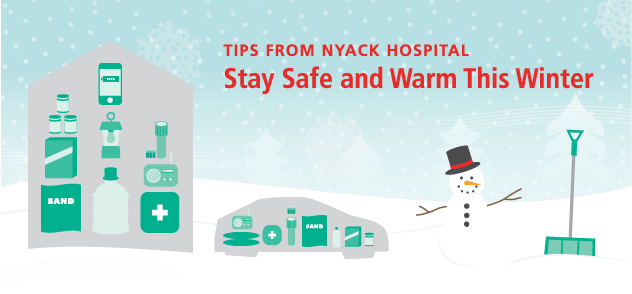
Winter weather can pose health and safety dangers. Plan ahead to make this winter a safe and healthy one for you and your family both inside and outside the home. Prepare for winter-weather emergencies, such as power outages. Have food in the pantry that doesn’t need to be cooked or refrigerated. Store water in clean containers. Keep your cell phone fully charged. Have a battery-operated flashlight, radio and lamps, with extra batteries. Also have a first-aid kit and extra medicine available, as well as salt or sand to use on icy walkways.
Your car should also be ready for winter. Keep a winter emergency kit in the car in case you end up stranded. Include blankets, food and water, a first-aid kit, flashlight, battery-powered radio, extra batteries, booster cables, flares, tire pump, and a bag of sand or salt for traction.
Keep safe when you are working outdoors in cold weather. Wear layers of light, warm clothing, as well as mittens or gloves, hats, scarves and waterproof boots with rubber or neoprene soles for better traction. Avoid “comfort shoes” with smooth soles, which make it easier to slip on icy surfaces. Sprinkle salt or sand on icy patches. If you will be participating in outdoor recreation, take a friend and an emergency kit with you, and carry a fully charged cell phone.
To shovel snow safely, take it slowly. If you have a history of heart problems, don’t shovel without your doctor’s permission. Shovel only fresh snow – it’s easier to shovel than wet, packed-down snow.
Other snow shoveling tips:
- Push the snow as you shovel, instead of lifting the snow out of the way.
- Use a small shovel, or only fill part of a large one to avoid straining yourself by picking up too much snow at once.
- Lift the snow with your legs bent, not your back. Bend and sit into the movement to keep your back straight. This puts less stress on your back.
- Take a break if you feel you’re running out of breath. Stop immediately if you feel any tightness in your chest.
- Dress warmly.
To avoid falling on ice or snow, beware of “black ice,” which is difficult to see. Walk on clear pathways or ones that have been treated with sand or salt. If you find yourself walking on a slippery surface, bend your body slightly forward and take shorter strides or shuffle your feet. When you get out of the car, make sure you won’t be stepping on any icy surface.
By thinking ahead and preparing yourself, your home and your car for winter weather, you can reduce your chances of injuries this season.



 Upcoming Events
Upcoming Events



